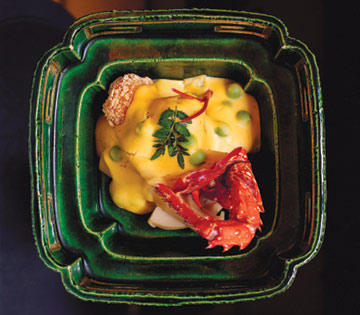
EDIBLE ART: Fried shrimp with an egg-yolk-and-green-pea sauce
(3 of 3)
But kaiseki is more than how the food tastes. "It is a dramatic art," he says. "With kaiseki, you need to tell a story." Take course No. 7, a small, sweet river fish called ayu. Grilled and adorned simply with salt, it can be eaten whole — head, tail, bones and all. "Here I am bringing guests to the riverbank in early summer," says Murata. "We are fishing, and grilling the ayu over a charcoal fire. This is how I communicate with the guest." He calls Kikunoi "an amusement park for adults." But only for patrons. The staff work as hard as coal miners. Every day Murata's fishmonger leaves his village on the coast at 1:45 a.m. to ferry the day's best catches to the kitchen. The chefs start at 6 a.m. and rarely finish before 11 p.m. Most live in dorms above the restaurant as they work through their five-year apprenticeships. On their days off, many take field trips to vegetable farms or visit local antique ceramic dealers so they can learn about the hand-crafted pottery so essential to kaiseki.
As in restaurant kitchens around the world, bad soft rock trickles from an unattended radio. I've spent a week rolling balls of shrimp in puffed rice for frying. I've folded bamboo leaves around sea bream and vinegared rice, and even sacrificed a few drops of blood to a Japanese knife while mincing mountain yam. But I always go back to the nori. One of the chefs confides to me that it's one of the most difficult tasks in the kitchen. I can't help but take that as a challenge, pick up my knife and start again. The bad music fades away, as does the ache in my wrists. I'm in the middle of a raucous kitchen, and for the first time in several months, I feel utterly at peace. I look down at my cutting board and find a pile of perfect threads of nori. The chef next to me scoops them all up and places them in the jar.